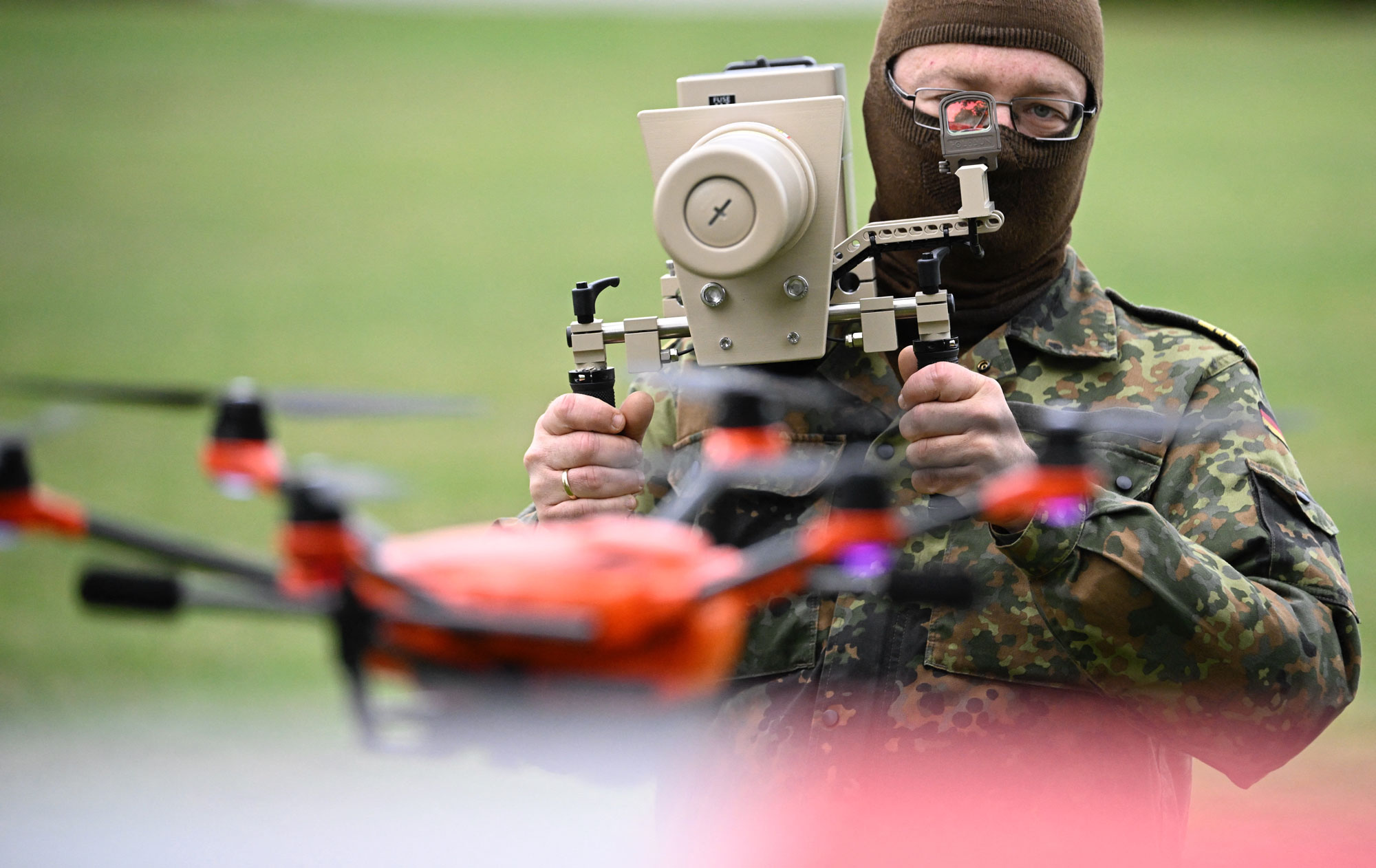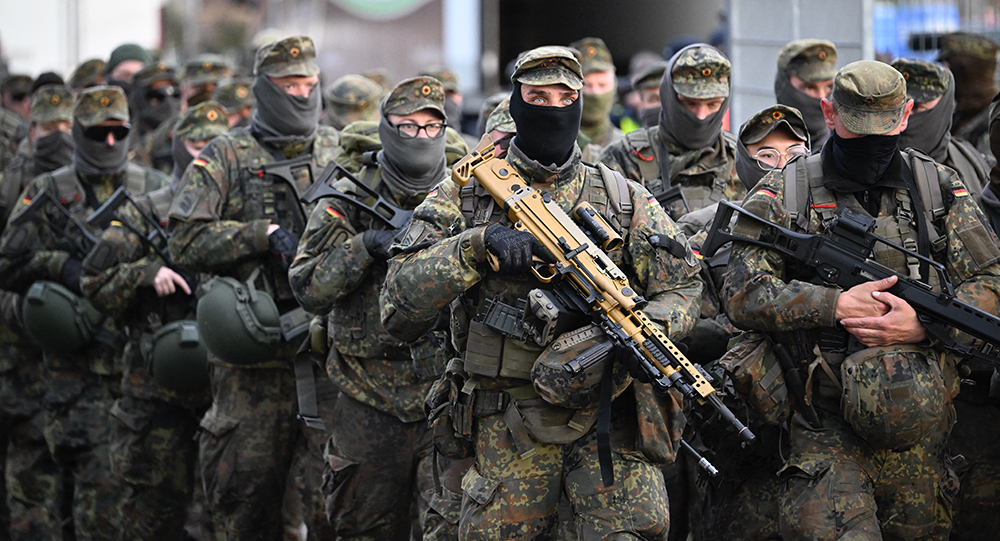
Hamburg
What would happen if Russia was planning an attack on Estonia, Lithuania or Latvia – and the threat was sufficiently great that Nato felt the need to send troops east across Europe to face off against Moscow?
This was the scenario the German Bundeswehr spent several days rehearsing last month, working out how the army would transport its soldiers towards Nato’s eastern flank in the event of conflict in the Baltics. For three days, the port city of Hamburg played host to the exercise Red Storm Bravo: 500 soldiers, along with roughly 300 members of the emergency services and other civilian organisations, took part – the largest military exercise in the city since the end of the Cold War.
Soldiers rehearsed setting up and manning checkpoints; the fire service fished out a sinking barge
In the event of conflict with Russia, Germany would, because of its geographical position, become a ‘hub’ for Nato to coordinate the flow of soldiers and weaponry to the front line in the east. Troops from the US and across western and southern Europe – including Britain – would flow through the country towards Warsaw and on. The purpose would be deterrence in the hope that a show of international force would put Vladimir Putin off an attack that would test Nato’s commitment to Article 5, which considers an attack on one member to be an attack on all.
It would be a huge operation: the Bundeswehr’s Operation Plan Germany, details of which were leaked to the press last year, envisages 800,000 Nato troops and 200,000 vehicles travelling across the country towards the front line. According to one army source, even with Germany’s motorways and ports used to full capacity, this would take close to a week. Red Storm Bravo was a rehearsal of the section of Operation Plan Germany that runs through Hamburg.
The purpose of Red Storm Bravo was as much to familiarise German civilians as the army with what to do in the event of a coming war. Only a fraction of the Operation Plan Germany soldiers were used but the scenarios neatly reflected the possible challenges. Soldiers rehearsed setting up and manning checkpoints; the fire service practised fishing a sinking barge out of Hamburg’s port; and the ambulance service simulated a mass casualty event with multiple victims.
The first day’s main event was moving a military convoy through the centre of the city after dark. As the sun set over Hamburg’s port, I watched the heavily armed soldiers march towards a fleet of about 70 military vehicles, lined up three abreast. Some were small armoured vehicles, others enormous Rheinmetall-branded trucks, several with machine-gun turrets that would later be manned as the convoy sped through the city. Many soldiers wore balaclavas to prevent them being identified, according to our Bundeswehr escort.
There is an art to travelling in a convoy. It moves as one, meaning that as long as the leading vehicle continues to move, the others follow suit in an unbroken line, regardless of red traffic lights or civilian traffic. This convoy of just 70-odd vehicles snaked back roughly 2.5 miles – a considerable logistical challenge.
At two points along the route, the convoy was stopped by pretend protests: at the first, army reservists in civvies waved banners and chanted at the convoy to ‘turn back’; at the second, ‘protestors’ staged a sit-in, with signs saying ‘glue’ around the necks of some to denote those who would have stuck themselves to the ground. The point was for the riot police to practise removing them. Groups of three took turns: a grab at the protestor’s head from behind and a knee to the back, one arm twisted around, then the other, allowing the police to peel them off the ground and carry them away.
When the planning for Red Storm Bravo was initiated, few could have predicted the new significance it would take on in the weeks leading up to it. Last month, a series of suspected Russian drone incursions into Nato territory set alarm bells ringing. Alongside Germany, Romania, Denmark, Norway and Poland have all reported drone activity close to military bases and other critical infrastructure. Meanwhile, three Russian MiG-31 fighter jets entered Estonian airspace for a total of 12 minutes on 19 September.
‘We developed the scenario for Red Storm Bravo last December and now reality has actually caught up with us somewhat,’ said Captain Kurt Leonards, the head of the Bundeswehr’s Hamburg command who oversaw the exercise. ‘Whether that’s in Poland, in Estonian airspace, or even the whole discussion now taking place in Denmark, it shows how topical this issue is, and that’s why we have to react very quickly and expand our capabilities.’
Poland and Estonia triggered Nato’s Article 4 less than two weeks apart, requesting alliance members come together to discuss the incursions. While the mood in Nato’s Brussels HQ appears to be calm so far, the rhetoric coming from individual members is somewhat more bellicose.
In comments supported by Nato chief Mark Rutte, Donald Trump gave his endorsement to any Nato ally shooting down Russian aircraft entering its territory. Poland and Lithuania have declared they will do precisely this. German Chancellor Friedrich Merz said: ‘We are not at war, but we are no longer living in peace either.’ The German government intends to change the law this autumn to allow the army to shoot down any drones deemed a threat. Last month the EU agreed to move forward with building a technological ‘drone wall’ along its eastern boundary.

The mood on the ground in Germany is clearly jumpy, too. At approximately 1 a.m. on a stretch of road just outside the centre of Hamburg, as the Red Storm Bravo convoy paused to set up for the second of its two protest simulations, a whining buzz became audible overhead. Alarm bounced around the crowd of assembled press and official observers as a small black drone hovered above us. ‘Is it one of ours?’ someone asked nervously. It was only after a press photographer was able to get a grainy shot of it that one of our military escorts confirmed it did indeed belong to the Bundeswehr.
‘We are not at war, but we are no longer living in peace either’
Leonards confirmed that Hamburg had seen an increase in drone activity. ‘Of course, you don’t always know where the drones are coming from,’ he said. ‘Are these drones the work of a state actor that’s systematically operating here? Or do we have a teenager with a remote-controlled drone who wants to test how fast the police can arrive on the scene?’
Following years of under-investment, the German army is restocking its arsenal thanks to reforms that will see defence spending exempt from the country’s rigid debt rules and a one-off €100 billion fund ringfenced by Merz’s predecessor, Olaf Scholz. Some of this will be invested in anti-drone technology.
In an army barracks in the Hamburg suburbs, the Bundeswehr demonstrated some of the gadgets already available. First to be sent up was a type of ‘hunter drone’ capable of ensnaring other drones mid-flight by shooting out a web, Spider-Man-style. Disabling drones this way avoids having to use expensive weaponry to shoot them down and lowers the risk of falling debris injuring civilians. Once the hunter drone had lowered its catch to the ground, a four-legged ‘drone dog’ dubbed ‘Lassie’, equipped with a camera and other sensors, was sent out to inspect it.
Nevertheless, questions over the German army’s readiness for conflict remain. In June, defence chief General Carsten Breuer warned that Russia could be ready to launch an attack on a Nato state by 2029; according to one government source I spoke to, this could be even sooner. Meanwhile, according to official figures, just under 183,000 soldiers are actively serving in the Bundeswehr, and a damning report published in May revealed that, at the end of last year, more than 20 per cent of military positions remained vacant. The reintroduction of conscription seems inevitable to meet its commitment to Nato troop numbers.
So, is Germany prepared for the defensive challenges ahead? When asked this, Leonards said: ‘Germany is in the process of significantly developing its armed forces and the Bundeswehr. And I believe we’re really on the right track.’ Not a resounding yes, then. But any preparation against an increasingly provocative Russia is better than none.








Comments